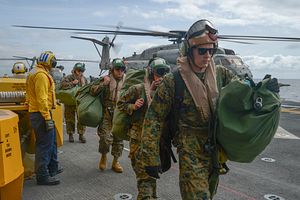The U.S. Navy and Marine Corps commenced a large amphibious exercise near San Diego last week that is demonstrating new warfighting concepts to counter the kind of threats they might face in a conflict in the Western Pacific.
Exercise Dawn Blitz 2017 is practicing or demonstrating key components of the Littoral Operations in Contested Environments concept (LOCE), a joint Navy-Marine concept released by the services earlier this year, including utilizing Marine mobile artillery systems for sea-based fires against targets on shore, establishing temporary expeditionary bases, and new flexible command and control structures to support those new capabilities.
The most high-profile demonstration was firing a Marine High Mobility Rocket Artillery System or HIMARS from the deck of the amphibious ship USS Anchorage. HIMARS is a truck-mounted system that can fire either guided rockets or the long-range Army Tactical Missile System. For the exercise, a HIMARS driven onto the Anchorage’s flight deck engaged and destroyed land targets 70 kilometers away, almost three times the effective range of the 5-inch guns that Navy ships typically use for shore bombardment in support of Marines.
Now that the Navy and Marine Corps have demonstrated a proof-of-concept using Marine artillery systems at-sea against shore targets and establishing Expeditionary Advance Bases, the next step is to direct those capabilities against adversary warships. The U.S. Army is developing an its own analogous concept to LOCE called Multi-Domain Battle and is slated to demonstrate sinking a target warship at next year’s Rim of the Pacific exercise using a mobile missile system.
Japan’s Ground Self-Defense Force is also participating in the U.S. Army’s “sinkex” next year and is a long-time participant in the Dawn Blitz exercises. Japan’s role in the United States’ efforts to develop capabilities for taking control of small islands and projecting sea and air control from expeditionary bases established on them highlights the role these concepts would play in a conflict with China in the Western Pacific.
The 2013 Dawn Blitz exercise was notable for its demonstration of “island seizure” capabilities with the Japanese Ground Self-Defense Force the year after China’s dispute with Japan over its administration over the Senkaku Islands intensified. The capabilities outlined in the LOCE concept and practiced in this year’s Dawn Blitz appear tailor made for the geography of Japan’s Southwest islands.
The exercise practiced what Marine Commandant General Robert Neller has called “the fight to get to the fight.” After fighting ashore with the help of Marine artillery like the HIMARS emplaced on the USS Anchorage, the Marines practiced establishing Expeditionary Advance Bases.
Temporary bases like these, established on archipelagoes like the islands stretching between Japan’s Home Islands and Taiwan or one of the island groups in the South China Sea, can then be used to project air and sea control using mobile sensor, artillery, and missile systems. HIMARS does not yet have a missile that can be used in an anti-ship capacity. The U.S. Army plans to use a Norwegian-made missile for its sinkex demonstration next year, but the Navy and Marine Corps are prioritizing developing a common missile that can be used by HIMARS as well as shipboard launchers.
By refining these concepts and backing them up with new missile and sensor systems, the United States and its allies hope to demonstrate a credible capability to operate in areas adversaries attempt to deny to them, and then turn around and deny that area to their adversaries. The capability is hoped to deter any attempt in the first place, but failing that, to roll-back their gains.

































